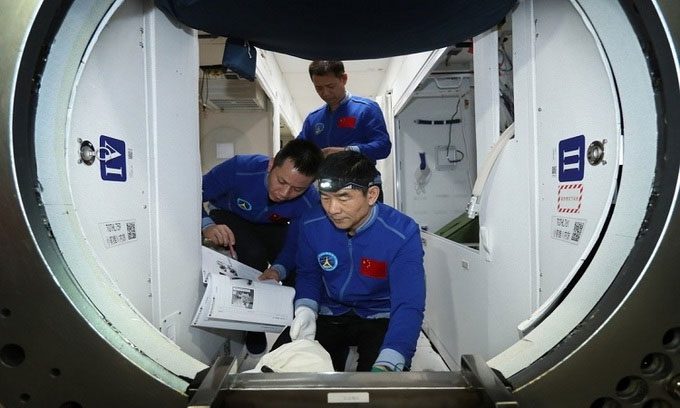The Tianhe Core Module is designed to provide maximum comfort for astronauts during their 3-month mission.
Three astronauts aboard China’s Shenzhou 12 spacecraft launched from Earth at 8:22 AM on June 17 from the Jiuquan Satellite Launch Center on the edge of the Gobi Desert. Commander Nie Haisheng, along with his colleagues Liu Boming and Tang Hongbo, had lunch on the Shenzhou spacecraft. After 6 hours, they entered the Tianhe core module of the space station currently under construction in orbit, successfully completing the docking maneuver.

The trio of astronauts Nie Haisheng, Liu Boming, and Tang Hongbo became the first to arrive at the Tiangong space station. (Photo: Xinhua).
During their 3 months in the Tianhe module, the astronauts will conduct two spacewalks. Before the launch, each astronaut carried a small rectangular box. According to experts, this is a handheld device with a power source and fan to ventilate their spacesuits before entering the cabin.
In contrast to the Chinese Tiangong 1 space laboratory prototype (which ceased operations in 2018), which had a living space of only 15m3, the crew in the Tianhe module will have a working area of 110m3.
According to the People’s Daily, the Tianhe module features 3 sleeping quarters and a bathroom, along with a treadmill and a stationary bike for the astronauts to maintain their fitness. The dining area includes a cooking stove, a sink, equipment for heating and cooling food, and a foldable table for astronauts to sit and eat. There are over 120 types of nutritious food available with a long shelf life.
Each astronaut has a handheld terminal equipped with an app to control the lights in the cabin or switch between work, sleep, and exercise modes according to personal needs. When showering, astronauts will use a spray gun to mist water. For sleeping, they need to use sleeping bags, but they can lie down instead of sleeping standing up.
In addition to their space duties, astronauts also have to train for other roles, such as cutting each other’s hair. Because hair strands float in a weightless environment, their toolkit includes a vacuum device to contain the hair.
The cabin in the Tianhe module is equipped with a Wi-Fi router to help astronauts maintain communication. They also use headsets to communicate with each other and with the command center on Earth, but each has a private channel to call their families.





















































